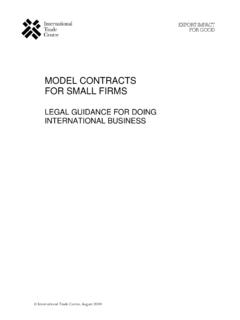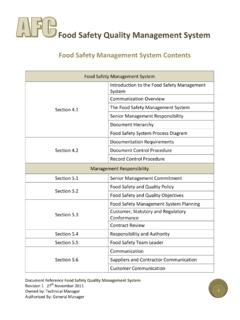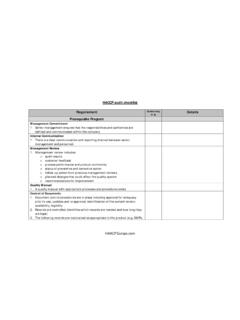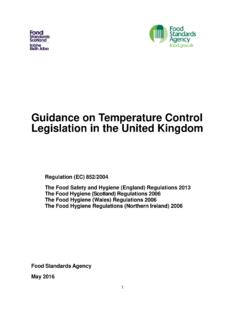Transcription of AN INTRODUCTION TO HACCP - International Trade Centre
1 BULLETIN No. 71/2002 AN INTRODUCTION TO HACCP AN INTRODUCTION TO HACCP ii The designations employed and the presentation of the material in this bulletin do not imply the expression of any opinion whatsoever on the part of the International Trade Centre (ITC) concerning the legal status of any country, territory, city or area or its authorities, or concerning the delimitation of its frontiers or boundaries. Mention of company names, commercial products and brand names does not imply the endorsement of ITC. While every effort has been made to verify the information contained in this document, ITC cannot accept any responsibility for any errors that it may contain. This bulletin consists of a directory of marks and labels related to food safety and geographical indications, environmental integrity and social equity. This list of marks and labels is an illustrative one and it is far from exhaustive.
2 This bulletin has been prepared, without formal editing as a service to exporters and industries in developing countries and economies in transition, under the guidance of S. K. Gujadhur, Senior Adviser on Standards and Quality Management, Enterprise Competitiveness Section, Division of Business and Institutional Support, International Trade Centre (ITC). For more information: Street address: ITC, 54-56 rue de Montbrillant, CH 1202 Geneva, Switzerland Postal address: ITC, Palais des Nations, 1211 Geneva 10, Switzerland Telephone: + Fax + E-mail: - Internet: AN INTRODUCTION TO HACCP iii Contents 1. What is HACCP .. 1 2. Principles of HACCP .. 1 3. Implementation of HACCP .. 2 4. HACCP and ISO 9000 .. 4 5. HACCP in International Trade .. 7 Annexes I. Example of decision tree to identify CCPs 9 II. List of selected websites where information about HACCP can be obtained 10 III List of selected documents on HACCP 11 AN INTRODUCTION TO HACCP iv AN INTRODUCTION TO HACCP 1 1.
3 What is HACCP HACCP is an abbreviation for the Hazard Analysis critical control Point system, which is synonymous with food safety management. It is a system which identifies, evaluates, and controls hazards which are significant for food safety. HACCP is a system that gives confidence that food safety is being managed effectively. The system looks for hazards , or anything that could go wrong regarding product safety, and implements controls subsequently to ensure that the product will not cause harm to the consumer. HACCP was developed originally as a microbiological safety system in the early days (1960s) of the US manned space programme, as it was vital to ensure the safety of food for astronauts. The Pillsbury Company working alongside the National Aeronautics and Space Administration (NASA) of the United States and the US Army Laboratories developed the original system.
4 A hazard as used in the HACCP system is defined as a biological, chemical or physical agent in, or condition of food, with the potential to cause an adverse health effect . A critical control Point (CCP) is a step at which control can be applied and is essential to prevent or eliminate a food safety hazard or reduce it to an acceptable level . HACCP is based on the principle that hazards affecting food safety can be either eliminated or minimized by prevention during production rather than by inspection of the finished product. Its goal is to prevent hazards at the earliest possible point in the food chain. The HACCP approach can be applied right from harvest to the point of consumption. Adding HACCP to traditional inspection and quality control activities would lead to a preventive quality assurance system in a company.
5 Companies using the HACCP system will be able to provide greater confidence about food safety to consumers as well as to food regulatory authorities. In many food processing industries established ways of operating, including methods of food processing and handling have become entrenched. The application of HACCP may require a fundamental change in the culture or attitudes of those involved in food processing. A good example is the need to establish a written procedural manual and for written records. In many industries there is no tradition of written procedures or records of quality or safety parameters, indeed the skill of the individual in many food processing situations is what is in their head . HACCP requires a fundamental change in attitudes, focused record keeping and documentation, even though many of the procedures to be documented themselves may remain unchanged.
6 Similarly, those attempting to implement HACCP may find it difficult to grasp the concept of risk-based food safety controls, particularly if they have been accustomed to controls based on pre-specified physical parameters that may bear little resemblance to the particular characteristics of the food processing operation in which they are involved. It is very important that all the people working in the company understand the HACCP system and that they maintain it. The adoption of HACCP simply to satisfy a regulatory requirement has the potential to lead to failure in that company. The HACCP system and guidelines for its application were developed by the Codex Committee for Food Hygiene on the Codex Alimentarius Commission, a joint Food Standards Programme of the Food and Agriculture Organization (FAO) of the United Nations, and the World Health Organization (WHO).
7 The HACCP system and guidelines were published in 1993 and revised in 1997. 2. Principles of HACCP The HACCP system consists of seven principles, which outline how to establish, implement and maintain a HACCP plan for the operation under study. Principle 1 Conduct a hazard analysis. Identify potential hazards associated with all stages of the production, using a flow diagram of the steps in the process. Assess the likelihood of occurrence of the hazards , and identify preventive measures for their control . Principle 2 Identify/Determine the CCPs. Determine the points/procedures/operational steps that can be controlled to eliminate the hazards , or minimize the likelihood of occurrence, or reduce the hazards to an acceptable level. AN INTRODUCTION TO HACCP 2 Principle 3 Establish critical Limits (target levels and tolerances), which must be met to ensure the CCPs are under control .
8 They must involve a measurable parameter and may also be known as the absolute tolerance or safety limit for the CCP. Principle 4 Establish a system to monitor control of the CCP by scheduled testing or observation. Principle 5 Establish the corrective action to be taken when monitoring indicates that a particular CCP is moving out of control . Corrective action procedures and responsibilities for their implementation need to be specified. Principle 6 Establish procedures for verification to confirm that the HACCP system is working effectively. Verification procedures must be developed to maintain the HACCP system and ensure that it continues to work effectively. Principle 7 Establish documentation concerning all procedures and records relating to the application of these principles. Records must be kept to demonstrate that the HACCP system is operating under control and that appropriate corrective action has been taken for any deviations from the critical Limits.
9 HACCP is not a stand-alone system. Good hygiene practices and other prerequisites for food processing as well as strong management commitment are also necessary; HACCP is not a substitute for these. Training is another essential requirement for a successful HACCP system. As an aid to developing specific training to support a HACCP plan, prepare working instructions and procedures that define the tasks of the operating personnel at each critical control point. 3. Implementation of HACCP HACCP is a system that assists organizations to identify potential food safety hazards in the entire food supply chain and to take preventive measures for their control . HACCP focuses on the prevention of hazards rather than relying on end product testing. The following sequence of 12 steps, included in the guidelines developed by the Codex Committee on Food Hygiene, is the recommended approach to develop a HACCP programme.
10 Step 1: Assemble HACCP team Set up a multi-disciplinary team that includes representatives from production, sanitation, quality control , food microbiology, etc. This team should be assigned specific segments of the food chain to be covered in the HACCP system, and be entrusted with developing a HACCP system as described from Step 2 onwards. Top management must give its full support to the team. If the required expertise is not available within the company, bring in help from a consultant. Step 2: Describe product Draw up a full description of the product for which the HACCP plan is to be prepared, including product composition, structure, processing conditions, packaging, storage and distribution conditions, required shelf life, instructions for use, etc. Step 3: Identify intended use Identify the intended use of the product by the end-user or consumer.














